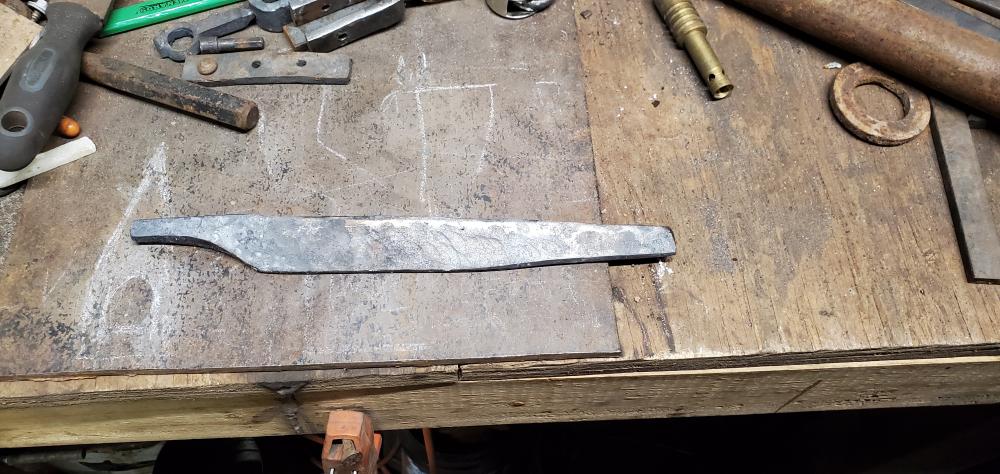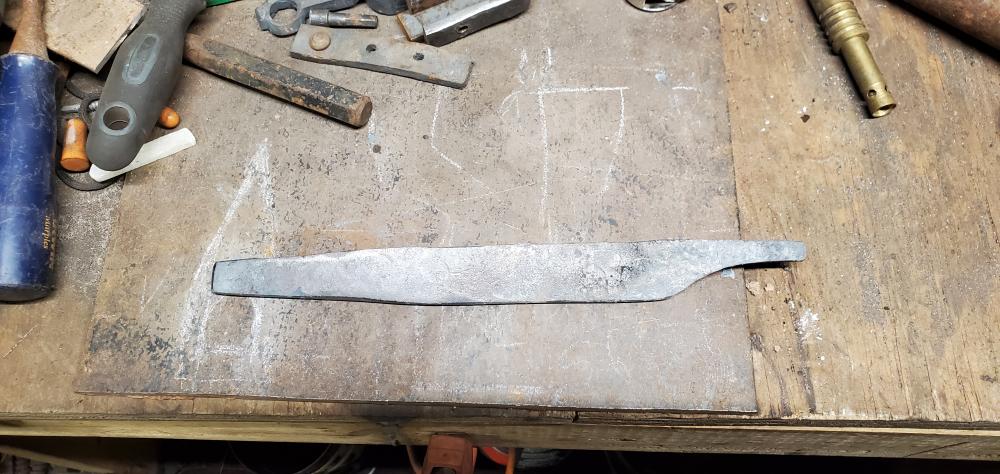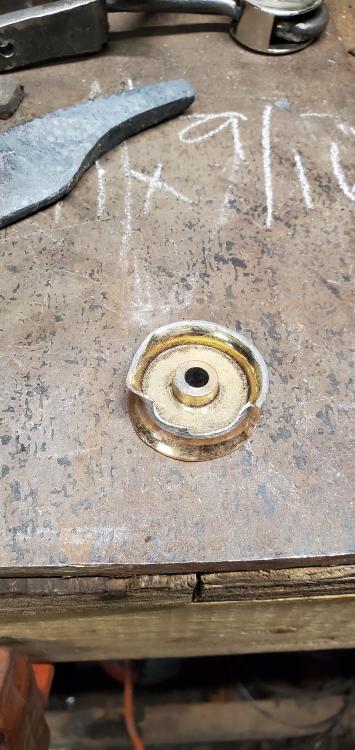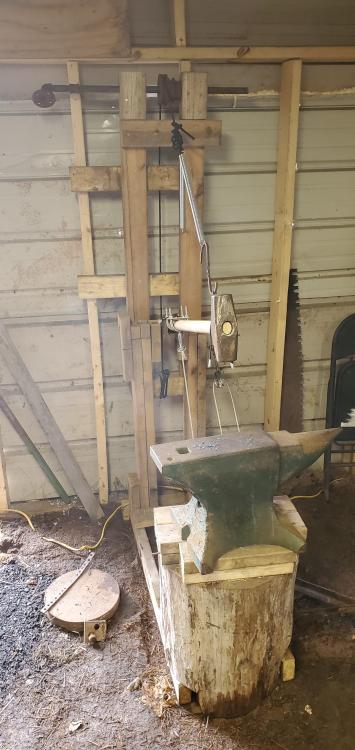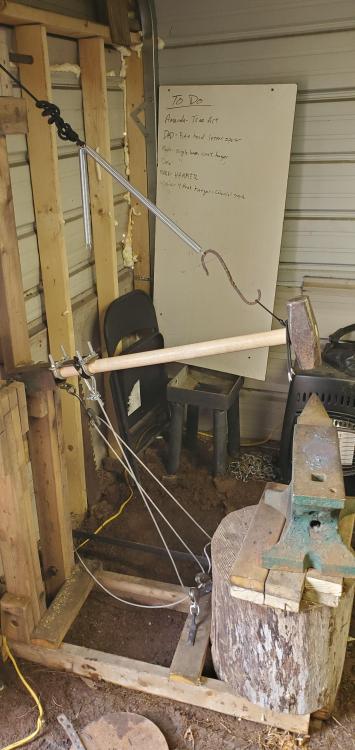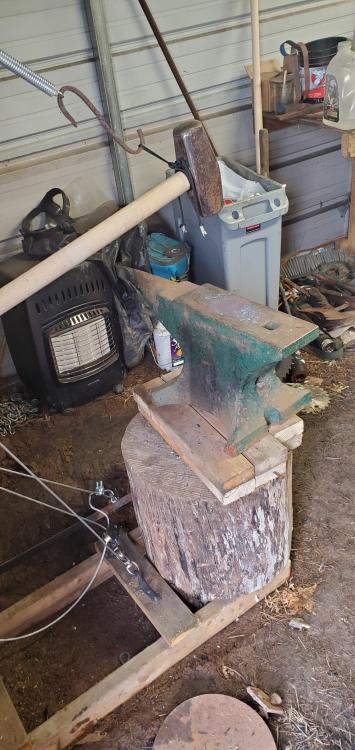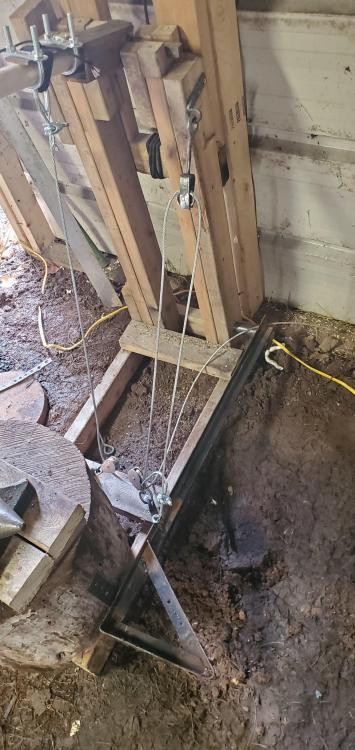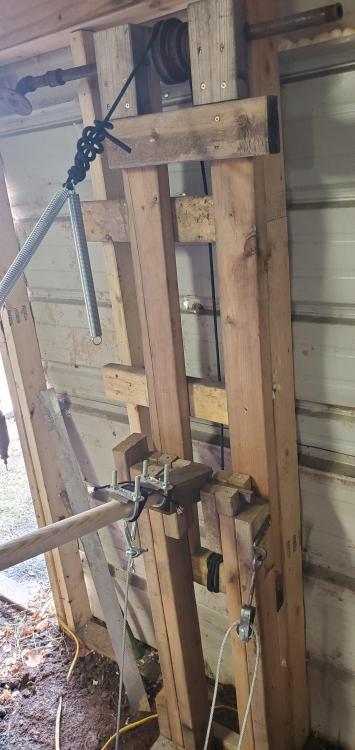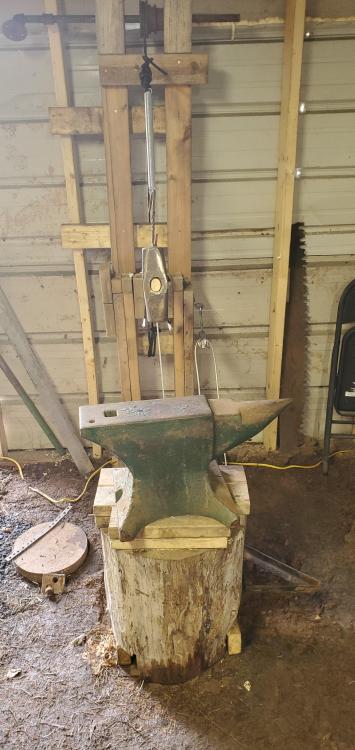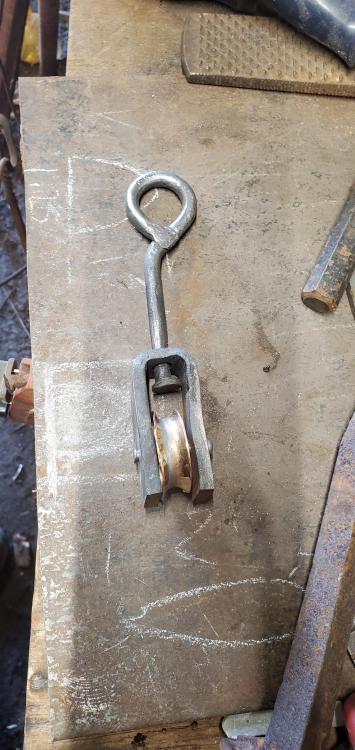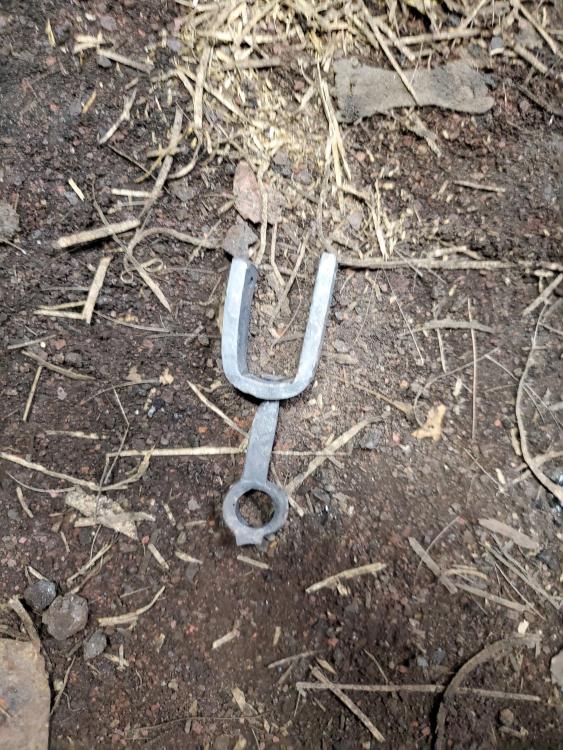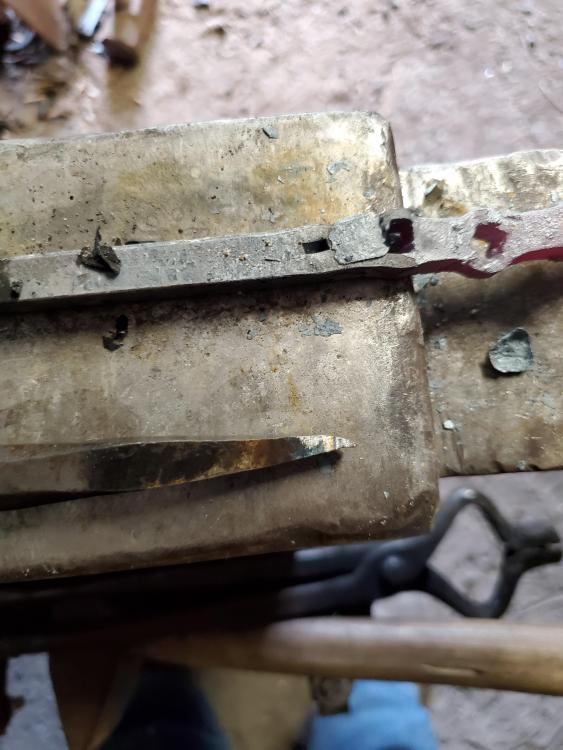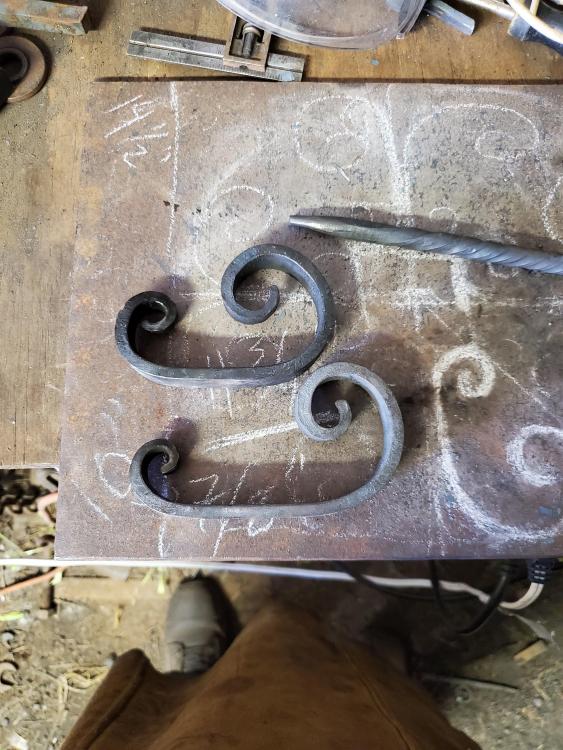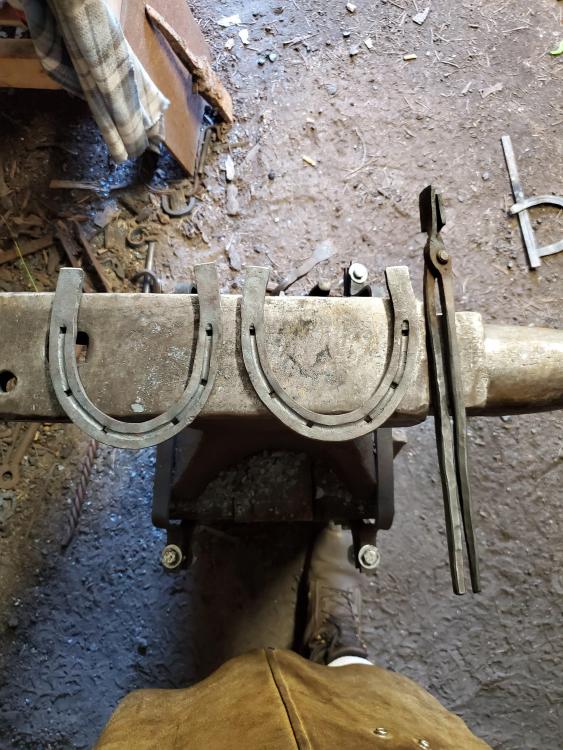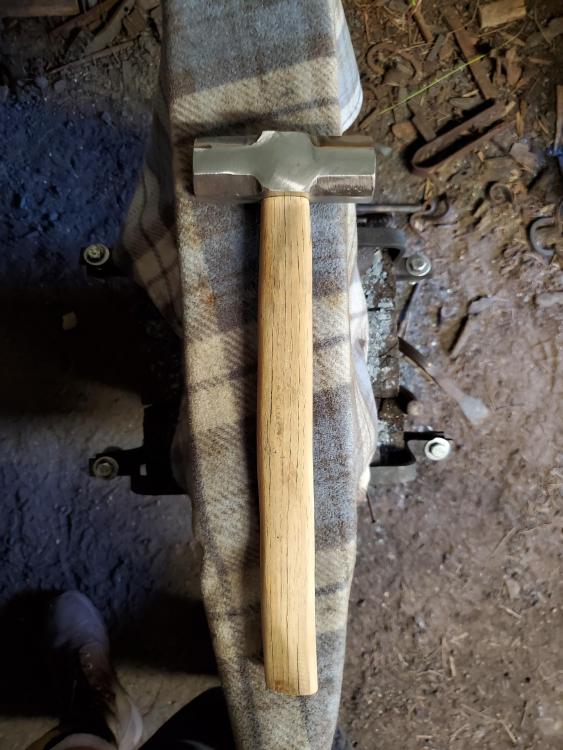
Dewnmoutain
Members-
Posts
95 -
Joined
-
Last visited
Content Type
Profiles
Forums
Articles
Gallery
Downloads
Events
Everything posted by Dewnmoutain
-
Quenching in old motor oil
Dewnmoutain replied to Glenn's topic in Heat Treating, general discussion
Not a bad idea -
Quenching in old motor oil
Dewnmoutain replied to Glenn's topic in Heat Treating, general discussion
Welll...i guess im buying some peanut oil tomorrow... -
What did you do in the shop today?
Dewnmoutain replied to Mark Ling's topic in Blacksmithing, General Discussion
Made an axe eye drift. Just some practice using mild steel to learn how it it works out. Pain in the butt. Needs cleanup, and truing of lines. -
How would you bend this?
Dewnmoutain replied to Dewnmoutain's topic in Blacksmithing, General Discussion
Welp...it broke. but! I had a brilliant idea. I can take some round stock, grind a slot into the center of the matieral to create that area for the cable to run though, and then drill a hole through the center of the material. -
George: yup. Im getting it. I have a projects book, where i write out completed projects....only have 2 entries in it since i got it in july, as i havent finished any projects. Yeesh...
-
Cuz Thomas asked I have a coal forge. Love it. Worked with a gas forge couple times, and im a bit iffy with it. Building my own scares the xxxx out of me, and i cant justify the cost of buying one. Anvil is a 120lb peddinghouse that is in desperate need of a grind job. I have a little belly in the center that is annoying me, and the edges are too rounded for a good cornering. I have a 2lb hammer that is my absoulte fav to work with. Got it in a estate sale and it just sat in the bottom of a bag for a couple years until i decided to try out handling a hammer. For presents...i was hoping to have started making axes for everyone. But my ollie hammer, and winterizing the shop so it doesnt snow inside the shop, took precedence. Tomorrow i plan to start making the drift for the axe head. Havent met patrick yet...kind of requires me to leave my house, and i still have issues with that. Snowed today. So thats cool. I love snow.
-
ollie hammer? or oliver hammer? Or treadle hammer? i forget It's got an 8lb sledge on it. My original hammer head was a 13lb, but it was really weirdly shaped and needs more work to make it usable. Just the couple times ive used it, i know i need to make the foot pedal longer because it forces me to be a bit unbalanced when i kick with my foot, and it's not allowing me to center my material when i hammer, allowing for mishits. But when it hits true, it really hits.
-
Been on this website now for a few months, and was cruising through here when i came across this section. I had seen it before and at the time thought "i'll get to that in a bit" and then forgot about it. until today... So, The name's Adam, and I'm from Northeastern Wisconsin, near Green Bay. Been hammering for roughly 5 years, and pretty much self taught on everything. I have taken a couple of classes on blacksmithing, one where i learned how to make a bottle opener (which, to be honest, was kind of a let down, not because of what was taught, but because there was 5 people to an anvil, which made it difficult to really do anything), and the second from a professional blacksmith (who had a very full opinion about himself) in a weekend class. I also took a damsacus bladesmithing class because i attempted pattern welding, and it failed horribly. I am an Army vet, and deployed to Iraq 08-09. (sucked. dont recommend the trip). As a result of that, i suffer from PTSD, which one of the side effects for me is limited mental capacity. I get frustrated when something that should be easy doesnt come together, or it takes a very long time for me to accomplish and looks like crap. (Like making leaves or spade points. Should be easy, but for reasons i still havent been able to figure out, the leaves look lop-sided. ) Another side effect is my people skills are not very good, which is fine when im alone in my shop, but interactions both in person and online leave something to be desired. (So i am giving everyone a preemptive 'Im Sorry' right now) I am trying to improve upon my craft. i know it's slow going for someone with my mental issues, but it is very frustrating, especially when i see someone who says "hey, i only started last month and look what i make" and it's something that i would eat my liver to be able to make. For myself, i know that i learn best in a classroom, watching someone do something and asking "hey, why did you do it that way?". I hope to be able to attend some more classroom training in the near future. Youtube is ok, but it's hard to ask questions. i guess that's why i like this website. I can ask questions and do get answers. heck, i even learn more than i intended to in some instances. (I still need to try that bending trick Glenn told me, with using sockets as a bend radius. Blew my mind when he told me that) So thanks for the help! not sure what else to say...
-
How would you bend this?
Dewnmoutain replied to Dewnmoutain's topic in Blacksmithing, General Discussion
im not looking for a magic trick. Just trying to get help with something that may seem easy to you, but for me, is just eluding me. And im frustrated because, as you said, this is something that is first week shop class difficult, only i never had a shop class, and the couple of blacksmith classes i did take didnt cover bending like this. -
How would you bend this?
Dewnmoutain replied to Dewnmoutain's topic in Blacksmithing, General Discussion
This way sounds interesting. Care to give me a nudge on where to look this up? Or perhaps know of a video that explains the process? I ended up making this....its really ugly. -
How would you bend this?
Dewnmoutain replied to Dewnmoutain's topic in Blacksmithing, General Discussion
Two follow up questions 1) the bold, i kind of understand what youre saying, but not able to visualize it. When you talk of the mandrel, youre saying the cone mandrel? Or is there another type of mandrel im not aware of 2) why am i using bending wrenches? Is it for better control of bending the metal? -
How would you bend this?
Dewnmoutain replied to Dewnmoutain's topic in Blacksmithing, General Discussion
Ahhhhhhhh ok im tracking now. Now i just need to figure out how to make that double bend...and how to make it swivel -
How would you bend this?
Dewnmoutain replied to Dewnmoutain's topic in Blacksmithing, General Discussion
How do you mean? -
Pulley broke on my treadle hammer. Thought id fix it by keeping the central wheel, replace the housing and O-ring to allow the pulley to handle the extra strain. So i made my measurements and drilled my holes, everything was looking nice. Riveted the O-ring to the piece and then made my bend. Had a piece of square steel that was the width i needed for the pulley wheel to spin freely without touching the sides. I ended up making the left and right sides of where this steel piece would line up and hammer on this steel piece, with the idea that id be able to bend both legs of this piece at the same time. And it worked...mostly. i heated the steel, set it over the jaws of my vice that was opened to a present distance to accomodate the steel piece plus the thickness of the steel material. as you can see in the photo, one leg is longer than the other. I have no idea how that happened as i had marked where the edges of the steel was to line up on the bending metal. So id like to know, how would you go about making the same bend? Let's say that it's a 5inch long piece of .75"W x .25"Thick flat stock, and you want to have a 1" inside gap. (The dimensions are close to what is shown in the picture)
-
Apologies for the rambling first post. I am not sure how to ask this quesiton, so i figure itd be better to provide as much info as i know up front to help you answer my questions, and also help me figure out things that im not even aware of to ask about or relay. For the last couple years ive been volunteering at a local Historical/heritage farm that has a functioning blacksmith shop. A forge, couple anvils, some leg vises, etc; the tools necessary to run a blacksmith shop. The purpose of the heritage farm, and by extension the blacksmith shop, is to showcase life and farming at the turn of the 20th century. The focus being life on a farm between the years of 1890 thru 1940s, with greater emphasis on dairy farming and the transition of farming equipment throughout the years. The farm itself was a family farm; the family well known in the local community. About 15 years ago or so, the family farm was converted into a local community heritage farm, and since then, the powers that be have been using the site to help preserve local farming history. After the site was established, a couple of guys (who's names i dont remember) decided that having a blacksmith shop on the premise would help contribute to the furtherance of historical knowledge and instruction. They started up the shop, in keeping with the scope of the heritage farm itself and the year setting. A new guy came along, name's Al, who helped build up and increase the size of the blacksmith shop. He used his own money to purchase forges, anvils, tools, accessories to ensure the success of the shop. Two years ago, i happened to be driving past the place, saw the "open" sign, and decided to stop and check things out. (Played a prank on Al and the other smith who was forging by asking if i could try "that hammer thingy". They let me, and two minutes after swinging the hammer they called me on it. we had a good laugh). Talked to Al, and he invited me to start hammering with them on friday's during the summer time. I agreed and started showing up. Speed up to last month. Al asks me "Hey, I'm getting old and i want you to take over the shop. Want to do it?" I told Al that i would take over.... but now i am sitting here trying to figure out what i just got myself into. I understand why he asked me. Im young, i have an active interest in blacksmithing, i own my own shop, and most importantly, i can swing the hammer without hurting myself. Now that we're in the process of closing up the shop for the winter, i am starting to give thought to next year when we can open the heritage shop again. The realization that i have agreed to run a shop that is a part of a historical site is starting to set in. And it dawns on me that i have no idea on how to do this. Sure, i have my own shop. But im not at the point where i even sell anything. I just make stuff for my family and friends, with the idea that one day i will be good enough to sell items. But running a heritage shop? i dont know. So here is the point where i do two things: 1) i posit my understanding of the situation, what i consider to be goals for the shop, ask questions and 2) you, the helpful reader, respond, give advice, and ask me questions to help me figure some things out. Here's what i know: The shop is designed to "replicate" the time frame between 1890s to 1940s. Granted, we do use electricity for indoor lighting and some power tools (band saw, bench grinder, a welder), for the most part, it's still human powered. We have a few anvils, a couple small and a large 200lb arm and hammer anvil that was donated by one of the board members. We have tongs of various types, couple large coal forges and several rivet forges. Some hand cranked blowers...i think im just rambling. you get the idea. it is set up, and runs. We are in the process of getting a new building that will be turned into a new blacksmith shop, as the current shop is an old granary building that the board wishes to convert back to a granary. The "new" building is 26x40ft, and is being moved from one old farm about 2 miles down the road to the heritage farm property in the next couple weeks. Since I took over the shop, I am the guy who get's to design the floor layout of the new shop, but also plan for an eventual woodshop to be housed in the same building. The shop doesnt make any money. Well, i shouldnt say that. The shop doesnt turn a profit. We do receive donations from the random people who stop and watch us work, and sometimes we will get up to $40 for our efforts. I know this is something that needs to change, and will be discussed further down. Al provided 90% of all the items in the shop, and has officially donated all items to the shop and the farm. Thoughts and concerns: one of the concerns that i have is properly running a historical blacksmith shop. I'm not going to try to say that this is a super-awesome-historically accurate blacksmith shop, similar in style to the Colonial Williamsburg shop. But for the most part, from my perspective, it's there. But, since ive never done this before, are there some things I need to be aware of that, well, im not aware of LOL. I know we arent going to play dress up and wear period accurate clothing; beyond that, im not sure what to consider. Making money: I got into a conversation with another blacksmith who volunteers at another historical site in the next county over. He has posited the following for me "Is the shop going to be self sustaining, or will it rely upon the main farm for monies to keep it operational?" i understand what he means, will the shop make its own product, and provide classes, making money so that it can be self-reliant, or will it have to rely upon the main farm for money to keep the shop running. And, i am not sure of how to go about figuring this out so that i can make a case to the heritage board for one way or the other. projects: Should i be doing a seasonal project that involves all the smiths, or just leave it to each individual smith to do his own thing? for the record, it's just me, and another guy who really just shows up for the camaraderie and the ability to get out of the house. Demonstrations: Im the one who ends up doing the demonstrations when we have the random visitor, so i talk to people and am able to give a decent demonstration. But when i do the demonstration, i always feel like it's lacking something. That i am winging it. Should i have some sort of routine that i show people? or something else? i know there is more, but i dont know enough about this topic to properly ask. Please feel free to ask me questions to help me figure out a scope and task for this shop. Thanks for the help.
-
Keep bending my slitter
Dewnmoutain replied to Dewnmoutain's topic in Slitters, Punches, Drifts, etc
one hit/quench is a pretty good idea. i'll give that a try and see what happens. i'll keep my eye out for some high alloy tool steel. -
This is frustrating! I made a slitter to slit a 1/4" hole, with the idea to drift the hole to 1/4" so i can hot fit the 1/4"" square stock for this project im planning to build. But the darn slitter keeps bending on me. Im cutting into 3/8ths square stock. I get the steel plenty hot to do the cuts with, but every attempt just leaves me with a slitter that i need to redress. I made the slitter out of an old chisel, and the chisel is 1/4". I hardened and tempered it, yet with every attempt i try in learning how to slit and drift, the slitter bends. In the picture you can see my new start, and after the second strike the slitter bent. Is the slitter to small for this idea of a project?
-
Not understanding what you mean
-
Decided to make a pot stand for camping. Going all fancy like and using some scrolls for decrative purposes. I drew out my scroll, as seen in the bottom right of the photo. I used some string and measured it out. Total length is 11.75 inches, made from 3/4x1/4" flat stock. I wanted to do a taper for the inner part of the scroll, so i did some math, and figured that having a 7/8ths" taper length for both ends of the bar would look nice, so 7/8ths plus 7/8ths equals 1.75", so i started with a 10" long piece of flat stock. I did my scroll work, bending, curling, and made the scrolls look like what i drew...but then saw that even though both scrolls on the piece matched, the runner between the scrolls was long. I took my string, measured, and found it to be 14.5" long. I thought i had cut my original piece long, so i slowed down, triple checked measurements. I cut my piece at 10", put my first taper of 7/8ths, giving me 10.875" long. Added second taper, and total piece length was 11.75". I proceeded to scroll. Made my scrolls line up, but the runner was on the long side again. Took my string, measured, and again, it was 14.5" long. So, im stumped. how am i gaining an extra 2"?
-
What did you do in the shop today?
Dewnmoutain replied to Mark Ling's topic in Blacksmithing, General Discussion
-
You know you have been hammering too long...
Dewnmoutain replied to Dewnmoutain's topic in Blacksmithing, General Discussion
Lol im happy if i can get to within 1/8th. -
Got a funny story to tell you. Today i was doing some finishing work on a basement stair project, and needed to cut some more 2x4s. I picked one up and set it down on my sawhorses. The 2x4 wiggled. I picked the wood up, looked at it,and saw a good warp twist on it. I said outloud to myself "meh, thats ok. I can put it in the forge and then hammer it flat." I picked the 2x4 up, took a step towards my shop and then reality hit me "wait a minute! You cant hammer wood flat! This aint steel" Yes, i smacked myself upside the head Hope you got a chuckle out of this
-
I think is an inch shorter. The blankie is soaked in oil to keep the anvil free of surface rust. Got sick and tired of hammering on the rusty face plate, so i sanded it down and just started covering it.
-
Was in the shop today, hammering with my forge hammer, and suddenly the head twistsd ever so slightly. I felt it twist on the strike and stopped. Sure enough, the wood inside the hammer head had come lose. i thought about it, thinking maybe a new wedge could work, but i knew deep down it wasnt. So i went scrounging through my hammer handle stash, trying to find an oblong shaped handle that best matched my old handle. Couldnt find anything, but i did have an old axe handle that roughly fit what i was looking for. I shaped the handle, where the hammer sets upon the wood, got the shoulders square, and made sure it fit. Then sanded down the years worth of grit and grime, to get to fresh wood below. Sanded the shaft down to 120grit for a smooth finish that i felt was right. I hate using handles that have a finish upon them, always feels like the hammer will fly out of my hand. Got it centered on axis, fitted and wedged. Used it a couple times, and now, i dont know. It feels right, but the thickness isnt what im used to. It feels a bit thin in my hand. It indexes well, and hammers much better than on the previous handle, but feels a bit...lite, i guess you could say. I'll try it for a few days, see how it works, how i adjust to it. Was curious to know if you guys had ever had this happen? Where you replaced a hammer handle and after it was put together, it just didnt feel right?
-
Yeah i know it's not whitesmithing. Never said that thats what i was doing...
